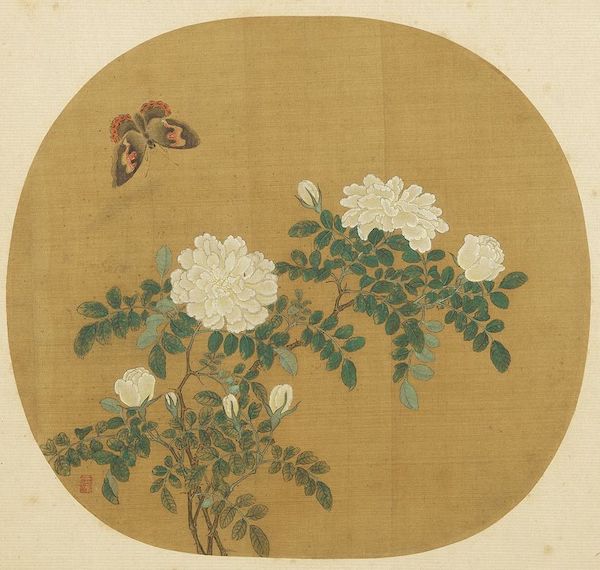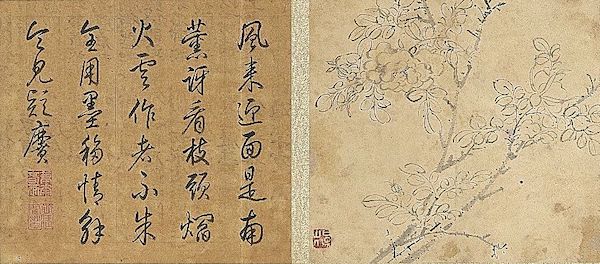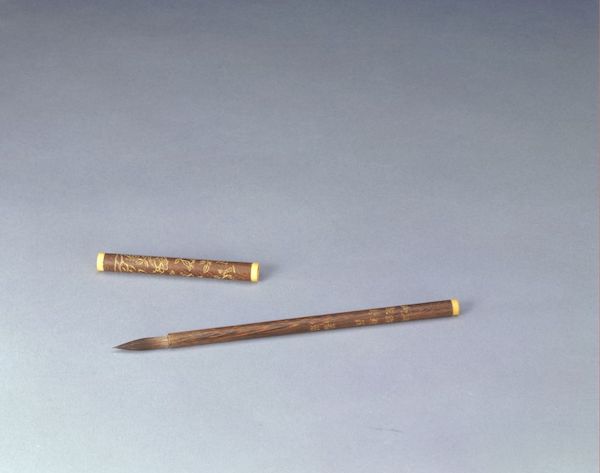
Among the famous paintings about roses in the past dynasties, either ink is elegant, or colorful: Ma Yuan's "White Roses" in the Song Dynasty, the painting style is clear and lively, Chen Chun's "Rose" in the Ming Dynasty, the use of ink is dripping and clear, Huayan's "Rose Mountain" in the Qing Dynasty "Birds" vividly explains the poetic meaning of "flowers are sunny in the sun, and birds are singing tenderly in the spring".
The column "Flower Letters from the Palace Museum" launched by The Paper in this issue presents the famous roses from the past dynasties collected by the Palace Museum and the Taipei Palace Museum.

April rose surging news map
Song Mayuan's "White Rose" page
Song Mayuan's "White Rose" page Collection of the Palace Museum
The white rose in the painting has huge flowers, lush branches and leaves, and is dazzling. The painter outlines the flower shape with a fine brush, smudges the petals with white powder, and paints the branches and leaves with shades of succulent green. The brushwork is rigorous and meticulous.
Song Mayuan's "White Rose" page (part) Collection of the Palace Museum

Song Mayuan's "White Rose" page (part) Collection of the Palace Museum
Ma Yuan (date of birth and death unknown, born during the Ningzong period of the Southern Song Dynasty, active in the early 13th century), courtesy name Yaofu, no. His great-grandfather, grandfather, uncle, brother and himself are all awaiting edict from the painting academy. From the Northern Song Dynasty to the Southern Song Dynasty. After the demise of the Northern Song Dynasty, Ma Yuan's grandfather followed Gaozong Zhao Gou to the south, so Ma Yuan was born and raised in Lin'an (now Hangzhou, Zhejiang), the capital of the Southern Song Dynasty. The approximate time of his activities was during the Guangzong and Ningzong years of the Southern Song Dynasty. Good at painting figures, landscapes, flowers and birds. Shanshui was originally inherited from the family, and later learned from Li Tang and came up with new ideas. The composition was mostly in the form of edges and corners. Together with the other three painters of the Academy of Painting Li Tang, Liu Songnian and Xia Gui, they are collectively known as the "Four Schools of the Southern Song Dynasty" in the history of painting.
Song Mayuan's "White Rose" page (part) Collection of the Palace Museum
The flower and bird painting of the Song Dynasty Academy of Painting inherited the tradition of the Five Dynasties and made some innovations on this basis. The painting method first outlines the outline with extremely fine lines, and then applies heavy colors and layers of smudges, often covering up the black lines, showing a very stable, delicate and luxurious charm.Song Makui "Spring Cong Wendie"

Song Makui, "Spring Cong Wendie" This painting is selected from the "Song and Yuan Collection Paintings" in the National Palace Museum, Taipei
The rose flower spreads out under the sky like a quiet, and a colorful butterfly flies. This is an ordinary scene. The artist uses the shape of flowers and leaves, and the colors of pink white, emerald green, and deep red are matched into a warm and pleasant picture. screen. The close-to-circle format should have been a painting on a fan, which was taken off and mounted after a period of time, but the shape of the fan may also have its own cuteness, so it was cut into a fan to write calligraphy and painting.Ma Kui was a painter in the painting academy during the Ningzong era (1194-1224) in the Southern Song Dynasty. In the Ma family, Ma Yuan was his younger brother, both of whom were famous painters.
Song Kesi Flower Album Rose

This painting of Rose is selected from the Song "Kesi Flowers" album in the National Palace Museum, Taipei
Kesi is woven with a simple plain wood machine, through warp and weft. First draw the pattern on the warp surface, put the various colored silk threads required for the drawing into the shuttle grooves, and according to the pattern design, shuttle back and forth between the warp threads of the graphic, leaving a jagged gap around, so Kesi is also known as Kesi. For "cut silk", it is a process of "creating something out of nothing". Kesi has a long history in my country. As the skills matured, it gradually became an art appreciation. Especially in the Song Dynasty (960-1279), craftsmen often looked for inspiration from painting and turned to copy famous calligraphy and painting, whether it was flowers and birds, landscapes, The works of Buddhism or stories are rich in content and reproduce the rich and colorful features of the paintings, and even the changes in details go beyond painting and show an extraordinary artistic realm.This piece is selected from the Song "Kesi Flowers" album.
Ming Chen Chun "Rose"

"Rose" This painting is selected from Chen Chun's "Painting Flowers" album in the National Palace Museum, Taipei
Chen Chun, a painter in the Ming Dynasty, is also known as Baiyang and Qingteng together with Xu Wei. Chen's young painters were meticulous, and after middle age, he indulged in his brushwork and established his own business. Chen Chun was under the tutelage of Wen Zhengming and had the highest reputation under his sect. He is good at freehand flowers. Although his works show a flower and a half leaves, it is dripping and refreshing, which is deeply appreciated by the literati and doctors at that time. He is a painter who has made important contributions to the development of ink and wash freehand flower and bird painting after Shen Zhou and Tang Yin.Emperor Gaozong of the Qing Dynasty inscribed on the piece of running script: "The wind is coming to face Nanxun, who is surprised to see the fire clouds on the branches. The author does not use ink completely, but his empathy and interpretation make people doubtful."
Ming Luzhi's "Rose Swallow"

"Rose and Swallow" This painting is selected from Lu Zhi's "Sketch from Life" album in the National Palace Museum, Taipei
Lu Zhi (1496-1576), courtesy name Shuping, was a painter in the Ming Dynasty. A native of Wu County (now Suzhou, Jiangsu), because he lived in Baoshan, he called himself Baoshan. Suave and addicted to righteousness, known as a filial friend. Lu Zhihao wrote poems and ancient prose, good deeds, calligraphy, and especially good at drawing. He studied poetry, calligraphy and painting from Zhu Yunming, Wen Zhengming and Shen Zhou. His study of Danqing was out of his chest, and he was famous for a while, and it was almost like Wen Qi. Xu and Huang's will to sketch from life. Dyeing flowers, birds, bamboo and stones is often made in heaven. Influenced by the Wu School, Shanshui also draws on the strengths of the Song Dynasty's courtyard style and green landscapes. The brushwork is steep, the scenery is dangerous, the artistic conception is clear, and it has its own style. It has a certain novelty among the painters of the Wu School, and is as important as Chen Chun in the world. In his later years, he was very poor. Some noble officials asked for a painting because of what they knew, and made several pictures to answer it. Its people are thick with their coins to thank. Zhi said: What I know is not poor. Stand it up. Those who ask for their paintings, if you ask them, you will not get them, but if you don't ask them, you may get them.This painting has a cursive postscript written by Wen Zhengming: "The roses are wet in the rain and the pale yellow is heavy, and the swallows are fluttering with the wind and the snow is light. Naturally, the painter has many meanings, and the idle window is very beautiful. Zhengming."
Tsinghuayan "Rose Mountain Bird" axis

Tsinghuayan "Rose Mountain Bird" axis collection of the Palace Museum
As a professional painter who is active in selling paintings in Yangzhou, Hua Yan's flower and bird paintings are good at capturing the most vivid natural interest in nature. In the spring season, a mountain bird perched on the branch of roses and chirped loudly. Its crisp chirping not only made the silent picture full of emotion, but also vividly explained the "sweet day of flowers and the sound of birds." The Poetry of Jiao Zhan Chun". The brush and ink of this painting are slick, the colors are elegant and elegant, the shape is natural and expressive, and the composition is simple and ethereal, showing the artist's extraordinary accomplishments in small freehand flower and bird painting and his unique and elegant style of painting.The inscription "Xinluoshan people wrote in the Xie Tao Pavilion". The seal "Huayan" is written in white, and the "commoner is born" in Zhu Wenyin.
Qing Jiang Tingxi rose

This painting of rose and mandarin duck tail is selected from the album of "Painting Flowers" by Jiang Tingxi in the National Palace Museum, Taipei
Jiang Tingxi (1669-1732), courtesy name Youjun, Yangsun, numbered Nansha, Xigu, also known as Qingtong Lay, was a native of Changshu, Jiangsu, an official during the Kangxi and Yongzheng periods of the Qing Dynasty, a painter, a bibliologist, and a bibliophile. The younger brother of Jiang Chenxi, the governor of Yunnan and Guizhou.Jiang Tingxi was a jinshi in the 42nd year of Kangxi (1703) and was awarded the Hanlin editor. After Emperor Yongzheng ascended the throne, he successively served as the Minister of Rites and Minister of Households. In the sixth year of Yongzheng (1728), he became a scholar of Wenhuadian University, and he was still in charge of household affairs, and served as the president of "History of the Ming Dynasty". The following year (1729), the Crown Prince was added. Tired and sealed first-class Adahahafan. Yongzheng ten years (1732) died in office, posthumous title "Wen Su".

This painting of Wild Rose is selected from the album of Jiang Tingxi's "Sketch from Life" in the National Palace Museum, Taipei

This painting of Rose is selected from the album of Jiang Tingxi's "Sketch from Life" in the National Palace Museum, Taipei
Jiang Tingxi has a good reputation in the government for upholding justice and eliminating accumulated malpractices. Knowledgeable and sensitive, especially good at poetry and painting. He is good at flowers and birds, sketches from life with an elegant brush, and works in a neat and correct manner.Qing Dynasty Chicken Wing Wood Tube Carving Imperial Poem Rose Flower Purple Pen

Qing chicken wing wood pipe carving imperial poem rose flower purple pen collection of the Palace Museum
The pen tube is a precious wenge wood with dense wood texture, and the natural texture of purple-brown varies in shades of light. The pen tube is engraved with the verse of rose flower inscribed by Emperor Qianlong of the Qing Dynasty: "The top grade has always been called light yellow, and it is easy to bloom for a long time. It is hard to bear the thorns. The thorns are unbearable, and the guards should ridicule the abalone." Yellow, to echo poetry, complement each other. The pen is purple, slender and slender, in the shape of a bamboo shoot, which was a popular pen style in the court of the Qing Dynasty.Modern and Modern Chen Shizeng's "Rose Picture" Scroll

Modern and Modern Chen Shizeng's "Rose Picture" axis collection of the Palace Museum
This picture is self-titled: "It's raining, but it's not clear yet. The new green shirt is light. The yellow rose has three colors, but it has a clearer flavor than the clove. Cane Qingzong is a senior brother. Xin Youzhongchun's teacher Zeng Chen Hengke." "Dead Taoist" seal. "Xin You" was the tenth year of the Republic of China (1921).Roses are rarely seen in ancient flower and bird paintings, but are more involved in modern painters. The most good at painting roses is Cheng Zhang from the Republic of China. Chen Shizeng's work is quite interesting in sketching. In the picture, the roses have long and slender branches, and the flower shapes are easily sketched. The gestures are natural and vivid, and the colors are soft. It truly and artistically expresses the beautiful and colorful roses.
(This article is compiled from the relevant materials of the Palace Museum and Taipei Palace Museum.)